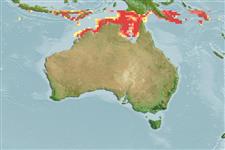Environment: milieu / climate zone / depth range / distribution range
Ecologie
marien demersaal; diepte 10 - 62 m (Ref. 6871). Deep-water; 8°S - 16°S
Eastern Indian Ocean and Southwest Pacific: northern Australia, southern New Guinea and eastern Indonesia.
Lengte bij maturiteit / Grootte / Gewicht / Leeftijd
Maturity: Lm 20.3, range 18 - 22 cm
Max length : 45.0 cm TL mannelijk / geslacht onbekend; (Ref. 9840)
Found offshore on continental shelf and feeds on bony fishes and crustaceans. Litters of 1-3 pups, born at 12-14 cm WD (Ref. 114953). Ovoviviparous (Ref. 50449)
Levenscyclus en paargedrag
Maturiteit | Voortplanting | Paaien | Eieren | Fecunditeit | Larven
Ovoviviparous (Ref. 205). Distinct pairing with embrace (Ref. 205).
Last, P.R. and J.D. Stevens, 1994. Sharks and rays of Australia. CSIRO, Australia. 513 p. (Ref. 6871)
Status op de Rode Lijst van het IUCN (Ref. 130435: Version 2024-1)
Gevaar voor de mens
Harmless
Gebruik door de mens
Visserij: van geen belang
Tools
Speciale rapporten
Download XML
Internetbronnen
Estimates based on models
Preferred temperature (Ref.
123201): 27.1 - 28.7, mean 28 °C (based on 140 cells).
Fylogenetische diversiteitsindex (Ref.
82804): PD
50 = 0.5039 [Uniqueness, from 0.5 = low to 2.0 = high].
Bayesian length-weight: a=0.01096 (0.00350 - 0.03435), b=3.12 (2.87 - 3.37), in cm total length, based on LWR estimates for this (Sub)family-body shape (Ref.
93245).
Trofisch niveau (Ref.
69278): 3.4 ±0.3 se; based on size and trophs of closest relatives
Weerstandsvermogen (Ref.
120179): laag, minimale populatieverdubbelingstijd 4,5-14 jaar (Assuming fecundity<100).
Fishing Vulnerability (Ref.
59153): Low to moderate vulnerability (35 of 100).
